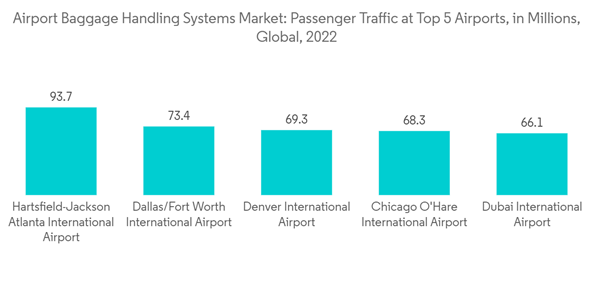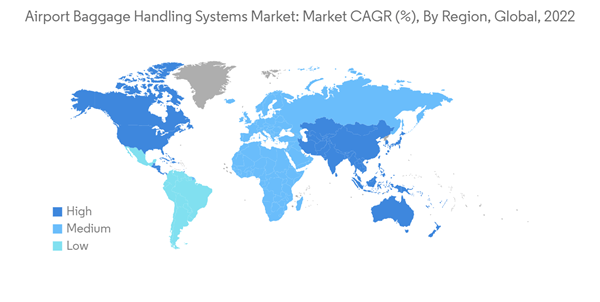The Airport Baggage Handling Systems Market size is estimated at USD 1.85 billion in 2024, and is expected to reach USD 3.39 billion by 2029, growing at a CAGR of 12.88% during the forecast period (2024-2029).
These companies have expanded their presence in various regions through partnerships with airport authorities and airlines. For instance, in December 2022, TSA launched a high-tech baggage handling system at Denver International Airport. The Checked Baggage Inspection System (CBIS) features a complicated network of conveyor belts that sort and track the luggage through the security screening process. The cost of the system was nearly USD 160 million. As the market demand improves with the growth in passenger traffic, it is expected that the smaller players are expected to gain a competitive advantage to cater to customers' needs.
This product will be delivered within 2 business days.
Key Highlights
- The airport baggage handling systems market is driven by the growth in the number of air passenger traffic in recent years. The modernization of new airports and technological advancements fuel the market's growth. The increasing focus on improving operational efficiency at airports is expected to lead the market's growth in the coming years.
- Technological advancements, such as robot utilization for baggage handling processes and endeavors, including establishing new airports and expanding existing terminals, are expected to show a positive outlook for the market.
- The renovation of baggage handling systems at various airports will also lead to growth in the market. In addition, most global airport authorities are now investing in renewing airport infrastructure to offer better comfort and baggage handling experience. According to the IATA International Air Transport Association, the global adoption of RFID can help the aviation industry save billions of dollars over the coming years.
- The aviation sector needs to be technologically updated to utilize its maximum potential. The check-in process during peak traveling consumes most of the time and is exhausting for the passengers. This process may be made convenient using automated kiosks, remote queue management systems, and remote check-ins, thus expected to fuel the market's growth in the coming years.
- Baggage mishandling has been a significant challenge for aviation authorities over the years. However, focus on better baggage tracking procedures and the introduction of the recent IATA's Resolution 753, which requires airlines to track bags at the four main touchpoints (make-up, loading, transfer, and arrival) across the journey, have helped reduce the number of mishandled bags over the last few years. Companies are investing in developing better baggage tracking technologies to obtain the data to comply with Resolution 753. Such investments are expected to drive the market's growth in the upcoming years.
Airport Baggage Handling System Market Trends
Above 40 million Segment Expected to Witness Significant Growth During the Forecast Period
- The above 40 million segment is expected to grow significantly during the forecast period. There is a significant increase in the number of airports entering the above 40 million passenger handling capacity segment. This is primarily due to the growing investments in expansion by major airports to cater to future passenger traffic and reduce congestion.
- For instance, Narita International Airport Corporation announced that the expansion of Terminal 3 of Narita International Airport was completed in April 2022. The expansion began in 2018 with an investment of JPY 14 billion (USD 111.7 million). The passenger handling capacity of the terminal increased from 7.5 million passengers per year to 15 million per annum. Similar projects are ongoing in several other countries in different regions. Such airport expansion projects are anticipated to generate demand for new baggage handling systems that would efficiently process passengers and baggage in the airport.
- Large airports in this segment are also trying to increase efficiency to reduce delays due to airport operations and congestion. In November 2022, Hamad International Airport (HIA) unveiled its impressive airport expansion project to the world. With this expansion of Phase 3, the airport passenger capacity reached 58 million passengers per year. The final expansion phase began in January 2023 and is expected to be completed by 2025, increasing the airport's annual capacity to approximately 70 million passengers.
Asia-Pacific is Expected to Dominate Market Share During the Forecast Period
- There has been a rapid increase in investments in airport infrastructure in Asia-Pacific to cater to the growing passenger traffic in the region over the past few years. Airports in China, India, Japan, and South Korea have witnessed exponential growth in passenger traffic in the past few years. As a result, the airport authorities have increased their investments in expanding existing airports and constructing new airports in the region.
- According to the data released by Airport Council International, the Asia-Pacific houses 57% of the total 300 new airports planned to open worldwide in the coming years. The newly planned greenfield airport will fulfill the vision of net zero emissions by 2050. According to ACI (Airport Council International), the Asia-Pacific is expected to account for 58% of the global air passenger demand, resulting in the region upgrading its airport infrastructure capacity with investments totaling USD 1.3 trillion till 2040 to accommodate such growth.
- Various countries in Asia-Pacific have started upgrading their airport capacity to accommodate the increasing number of air passenger traffic. For instance, as part of China's 14th Five-Year Plan (2021-25), the country plans to increase its civil aviation capacity with accelerated investments in airport construction. Under this new five-year plan, the Civil Aviation Administration of China (CAAC) plans to open over 30 new civil airports and increase the civil aviation capacity by 43%. Similarly, in March 2021, Vanderlande Industries (VI) Australia was awarded a contract to supply a new baggage handling system (BHS) to Western Sydney International Airport (WSIA). The BHS would utilize digital technology to track, load, and move baggage more efficiently. The new airport is expected to enter operational readiness and acceptance trials (ORAT) in late 2024 and begin operations for international and domestic services in late 2026.
- With such robust expansion plans, the demand for new airport baggage handling systems in this region is expected to grow during the forecast period.
Airport Baggage Handling System Industry Overview
The airport baggage handling systems market is semi-consolidated, with few players holding significant shares in the market. Some of the prominent players in the market are Siemens AG, SITA, Beumer Group, Vanderlande Industries, and Leonardo SpA.These companies have expanded their presence in various regions through partnerships with airport authorities and airlines. For instance, in December 2022, TSA launched a high-tech baggage handling system at Denver International Airport. The Checked Baggage Inspection System (CBIS) features a complicated network of conveyor belts that sort and track the luggage through the security screening process. The cost of the system was nearly USD 160 million. As the market demand improves with the growth in passenger traffic, it is expected that the smaller players are expected to gain a competitive advantage to cater to customers' needs.
Additional Benefits:
- The market estimate (ME) sheet in Excel format
- 3 months of analyst support
This product will be delivered within 2 business days.
Table of Contents
1 Introduction
4 Market Dynamics
5 Market Segmentation
6 Competitive Landscape
Companies Mentioned (Partial List)
A selection of companies mentioned in this report includes, but is not limited to:
- Daifuku Co. Ltd
- Alstef Group
- Siemens AG
- CIMC TianDa Holdings Co. Ltd
- Vanderlande Industries Holding BV
- BEUMER Group
- G&S Airport Conveyer
- Ansir Systems
- SITA
- Leonardo SpA
Methodology

LOADING...










